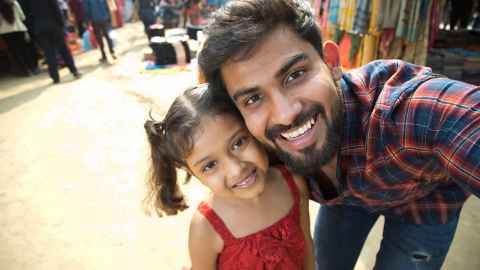Aotearoa's child privacy laws must be improved
15 June 2022
Aotearoa New Zealand has a long way to go in enhancing its laws to protect child privacy rights in the age of sharenting, says privacy law expert Nikki Chamberlain.

As parents and caregivers pepper social media with photos of their children's milestones and day-to-day activities, University of Auckland academic Nikki Chamberlain says we need improved laws and heightened awareness to ensure we're doing what's best for our young people.
"Privacy law protections are not keeping up with advancements in technology," she says. "As a result, a child is particularly vulnerable in the social media space."
Chamberlain delves into the country's lack of safeguards amidst our quickly changing social media landscape in a chapter of her forthcoming book, Privacy Law in New Zealand (third edition), co-edited with Stephen Penk.
Titled “Privacy and Children”, the chapter details the phenomenon of "sharenting" on social media, canvasses existing statutory and common law privacy protections in New Zealand, discusses progressive overseas developments and suggests options for reform.
One of the key concerns around child privacy is third parties who use social media to gather data on, and/or use the data to manipulate, child internet users, says the author.
Another significant issue is the use of a child's image on social media without their informed consent, particularly by their parents or legal guardians.
Chamberlain says this issue has proliferated through "mummy bloggers" and the use of "child influencers", culminating in what some academics term “sharenting” or “generation tagged”.
Sharenting refers to parents who overshare information or images relating to their child on social media platforms like Facebook, Instagram, TikTok and YouTube.
Chamberlain says sharenting is prolific, and the harms caused by oversharing online are alarming when framed with the lens of what is in the best interests of the child.
"A child can be subject to sharenting at any age, and younger children are particularly vulnerable as they may not be able to voice their objection or have that objection heard."

Sharenting can be for commercial or social purposes, says Chamberlain.
A common example of commercial sharenting is a parent who sets up a social media page on behalf of their child and posts pictures of that child marketing various commodities such as clothing or toys. If successful, the child amasses a large social media following, becoming a "child influencer" who earns an income from social media posts.
An example of non-commercial sharenting is a parent who regularly shares information or images of their child on social media often to build community and stay connected to others.
Chamberlain says the most obvious disadvantage of oversharing is the impact it can have on a child's welfare and social development.
"A child has a distinct lack of control over how their image is used, as the legal authority for decision-making primarily vests in the parents or legal guardians," she writes, noting that a child may not wish to be in the public eye on social media and that they may suffer abuse from their peers or online "trolls".
Meanwhile, commercial sharenting creates specific disadvantages, says Chamberlain.
"First, the child may feel pressure to comply with the parents' or guardian's wishes to be on social media as they may be the primary breadwinner of the family – being an 'influencer' can be extremely lucrative."
In extreme cases, the privacy expert says there can be commercial exploitation of the child to support the family which, in turn, may lead to the child disengaging in regular social developmental activities.
Further, unlike other industries, such as the film industry, Chamberlain says New Zealand doesn't have laws specifically aimed at protecting the commercial use of a child's image on social media.
"In this respect, there is potential for grave mismanagement of a child's image being used on social media and the income derived from that use."
Image manipulation, child sexualisation, physical stalking and kidnapping are other risks that can stem from using a child's image online.
The government could undertake an advertising campaign about the dangers of sharenting on social media.
So, what legal protections are available to prevent the exploitation of children through sharenting on social media? Very few, says Chamberlain.
The author says New Zealand has a long way to go in enhancing its laws to protect child privacy rights in the age of sharenting and says any reform needs to prioritise the child's needs.
In researching the subject, Chamberlain examined common law sources and legislation, designed, but unable to satisfactorily protect children's privacy, including New Zealand's Privacy Act 2020, the Care of Children Act 2004 and the Broadcasting Standards Act 1989.
Chamberlain says that with child privacy protections coming from a number of different statutory and common law sources, the country is left with a disjointed legal landscape for protecting child privacy.
In terms of improving the current landscape to better respect child privacy in Aotearoa,
she says legislation could be enacted to clarify and strengthen the protection of child privacy rights on social media by prohibiting commercial entities and parents from exploiting children on social media.
"For example, in France, a new law was passed unanimously under the French Labour Code which specifically protects the hours worked and income earned by child influencers under the age of 16 years old. The law provides that any income earned by the child influencer must be placed in a bank account until they turn 16 years old and, further, that companies wishing to employ child influencers must receive permission from the relevant local authority. The law also codifies the right to be forgotten in France so that a child can request the removal of content about him or her online. Of course, the right to be forgotten is also codified in the United Kingdom’s General Data Protection Regulation 2016," says Chamberlain. "We do not have an equivalent law in New Zealand.”

Chamberlain says legislation could also establish a Children's Digital Ombudsman, or expand the protection powers of the Children’s Commissioner or the Privacy Commissioner, so that third parties can lodge complaints to an independent watchdog in relation to the concerning use of a child’s image or identity on social media. In addition, the legislation could require, for example, users of Facebook aged between 13 and 18 to have their profiles set to private.
Adopting a public health model whereby funding is allocated to educate parents on the harms of sharenting could also help educate and inform parents and caregivers about the risks.
"The government could undertake an advertising campaign about the dangers of sharenting on social media," says Chamberlain.
The privacy law expert says the New Zealand judiciary should continue to develop common law privacy protections, including breach of confidence, public disclosure of private facts, intrusion into seclusion, and adopt a misappropriation of likeness tort to protect child privacy rights on social media.
Nikki Chamberlain is a senior lecturer at the University of Auckland's Faculty of Law.
The forthcoming book, Privacy Law in New Zealand (third edition), edited by Nikki Chamberlain and Stephen Penk, is available from 31 July 2022 and is published by Thomson Reuters.
Media Contact
Sophie Boladeras | Media adviser
M: 022 4600 388
E: sophie.boladeras@auckland.ac.nz